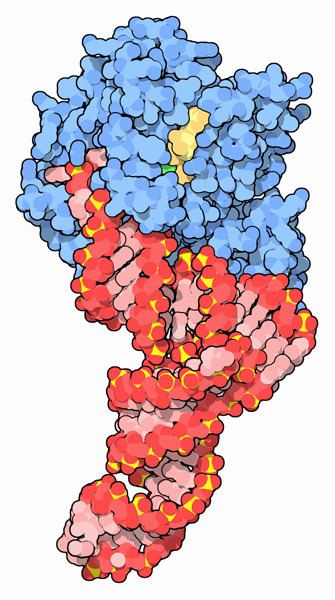 | ||
EF-Tu (elongation factor thermo unstable) is one of the prokaryotic elongation factors. Elongation factors are part of the mechanism that synthesizes new proteins by translation at the ribosome. Individual amino acid links are added to the protein chain by transfer RNA (t-RNA). Messenger RNA (mRNA) carries a codon that codes for each amino acid. t-RNA carries the amino acid and an anticodon for that amino acid. The ribosome creates a protein chain by following the mRNA code and selecting the next t-RNA and its amino acid.
The prokaryotic factor EF-Tu helps the aminoacyl-tRNA move onto a free site on the ribosome. In the cytoplasm, EF-Tu binds an aminoacylated, or charged, tRNA molecule. This complex enters the ribosome.
There are 3 tRNA attachment sites on the ribosome: aminoacyl (A), peptidyl (P) and exit (E). The tRNA complex first binds to the A site, then moves to the P site, and is released at the E site.
The tRNA anticodon domain associates with the mRNA codon domain in the ribosomal A site. If the codon-anticodon pairing is correct, EF-Tu hydrolyzes guanosine triphosphate (GTP) into guanosine diphosphate (GDP) and inorganic phosphate. This creates a conformational change in EF-Tu that causes EF-Tu to dissociate from the tRNA of the ternary complex (and therefore leave the ribosome). The aminoacyl-tRNA then fully enters the A site, where its amino acid is brought near the P site's polypeptide and the ribosome catalyzes the covalent transfer of the polypeptide onto the amino acid . The tRNA on the P site (without peptide) moves to the E site and is then released.
EF-Tu contributes to translational accuracy in three ways. It delays GTP hydrolysis if the tRNA in the ribosome’s A site does not match the mRNA codon, thus preferentially increasing the likelihood for the incorrect tRNA to leave the ribosome. It also adds a second delay (regardless of tRNA matching) after freeing itself from tRNA, before the aminoacyl-tRNA fully enters the A site. This delay period is a second opportunity for incorrectly paired tRNA (and their bound amino acids) to move out of the A site before the incorrect amino acid is irreversibly added to the polypeptidic chain. A third mechanism is the less well understood function of EF-Tu to crudely check aminoacyl-tRNA associations and reject complexes where the amino acid is not bound to the correct tRNA coding for it.
